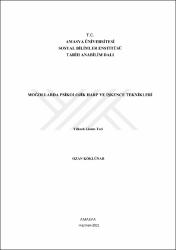Moğollarda psikolojik harp ve işkence teknikleri

View/
xmlui.dri2xhtml.METS-1.0.item-rights
info:eu-repo/semantics/openAccessDate
2021Metadata
Show full item recordAbstract
Orta Çağ'da devletler, varlıklarını korumak amacıyla yoğun şiddet içeren politikalar kullanıyorlardı. Şiddet, savaş ve ölüm bu çağda en çok rastlanılan olgulardı. Ulusların ve devletlerin varlıklarını korumaları bu üç olguyla ilişkiliydi. Bu çağın önemli askerî potansiyele sahip uluslarından Moğollar 13.Yüzyılda Cengiz Han'ın önderliğinde güçlenerek dünya tarihinde şiddet dolu hatıralar bırakan bir imparatorluk meydana getirdiler. Bu askerî yönüyle ön plâna çıkan bir korku imparatorluğuydu. Cengiz Han'ın inşa ettiği imparatorluğun isminin korku ve ölüm kelimeleriyle birlikte anılmasının nedeni ise Orta Çağ şartları gereği uygulanmış olan stratejilerdir. Moğolların Gizli Tarihi'nde Moğolların yüzyıllardır başka uluslar tarafından saldırılara ve hakaretlere maruz kaldıklarından, onları bu durumdan kurtaracak bir han beklediklerinden bahsedilir. Beklenen kutlu han olduğu iddiasıyla ortaya çıkan Cengiz Han hem Moğolların hem de rakip ulusların korkularını kullanmakta başarılı olmuştur. Bu noktada anahtar terim ulusal onur kavramıdır. Moğolların yüzyıllarca saldırı ve hakarete maruz kalmaları onların onurlarını zedeleyen bir durumdur. Ayrıca topluma mal olmuştur. Cengiz Han'ın hükümleri, etkileyici konuşmaları ve savaş stratejileri de uzun zamandır zedelenmiş olan ulusal onur etrafında şekillenmiştir. Cengiz Han Moğolları önceki yıllarda olduğu gibi zayıf bir duruma düşmemek için savaşma, zafer kazanma ve fethetme yönünde harekete geçirmişti. Moğol ulusu zafer kazandıkça güçlenecek ve ataları gibi zayıf olmayacaktı. Kendi ulusunu korkularından beslenerek motive eden ve durdurulamaz bir savaş potansiyeli kazandırırken, düşmanlarını korkutmayı ve korkularından istifade etmeyi tasarlamıştı. Cengiz Han bu amaçla pek çok psikolojik harp stratejisi geliştirdi ve savaşlarda kullandı. Cengiz Han'dan sonra tahta çıkan Moğol hanlarının çoğu da tıpkı onun gibi Karadeniz'in kuzeyinden Anadolu'ya, İran'dan Çin'e kadar uzanan bu büyük imparatorluğu idare etmek için insan psikolojisini etkin bir biçimde kullandılar. Hâkimiyet algısını güçlü tutmak ve itaat kültürü oluşturmak amacıyla gerek düşmanın gerek savaşın şartlarına göre tasarlanan psikolojik harp stratejileri uyguladılar. Hâkimiyet ve itaat kazanma politikalarının merkezine korkuyu alan Moğolların kullandıkları psikolojik harp stratejileri beraberinde pek çok işkence tekniğini de getirdi. Bu çalışmada Moğolların kullandıkları psikolojik harp stratejilerinin ve yaptıkları işkencelerin insanların üzerindeki etkisi incelenmiş, imparatorluğun idaresindeki yeri değerlendirilmiştir. In the Middle Ages, states used violent policies to protect their existence. Violence, war, and death were the most common phenomena in this age. The preservation of nations and states was associated with these three phenomena. Mongols, one of the nations of this age with significant military potential, grew stronger in the 13th century under the leadership of Genghis Khan and formed an empire that left violent memories in world history. It was an empire of fear that stood out with its military side. The reason why the name of the empire built by Genghis Khan is associated with the words fear and death is the strategies applied in accordance with the conditions of the Middle Ages. In the Secret History of the Mongols, it is mentioned that the Mongols were subjected to attacks and insults by other nations for centuries and that they were waiting for an inn to save them from this situation. Genghis Khan, who claimed to be the holy inn expected, was successful in using both the fears of the Mongols and the fears of rival nations. The key term at this point is the concept of national honor. The fact that the Mongols were attacked and insulted for centuries is a situation that damaged their dignity. It has also cost society. Genghis Khan's rulings, impressive speeches, and war strategies are also shaped around long-damaged national dignity. He motivated the Mongols to fight, triumph and conquer, in order not to fall into a weak situation as in previous years. The Mongolian nation would grow stronger as it triumphed and not be weak like their ancestors. He designed to frighten his enemies and take advantage of their fears while giving his own nation an unstoppable war potential that motivates and feeds on its fears. Genghis Khan developed many psychological warfare strategies for this purpose and used them in wars. Many of the Mongol khans who ascended the throne after Genghis Khan, just like him, used human psychology effectively to govern this great empire that stretched from the north of the Black Sea to Anatolia, from Iran to China. They applied psychological warfare strategies designed according to the conditions of both the enemy and the war in order to keep the perception of domination strong and to create a culture of obedience. The psychological warfare strategies used by the Mongols, who placed fear at the center of their policies of domination and obedience, brought with them many torture techniques. In this study, the psychological warfare strategies used by the Mongols and the effects of their torture on people were examined and their place in the administration of the empire was evaluated.
URI
https://tez.yok.gov.tr/UlusalTezMerkezi/TezGoster?key=tqUiYt63sTQLTpozMJ92QrDTMqILVEh7ejgr7UtMPbtn-0NG--yEjh3vJndus6zehttps://hdl.handle.net/20.500.12450/1973
Collections
- Tez Koleksiyonu [318]

















